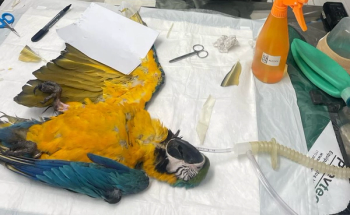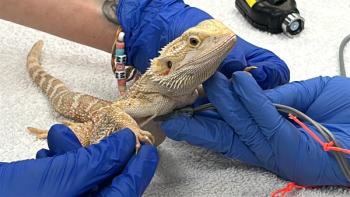
Clinical Exposures: Biliary cystadenomatosis in a ferret
A 6.5-year-old neutered male ferret was presented for evaluation of anorexia and a six-month history of progressive abdominal enlargement.
A 6.5-year-old neutered male ferret was presented for evaluation of anorexia and a six-month history of progressive abdominal enlargement. Radiographs demonstrated an abdominal mass, and a multicystic hepatic mass was identified during laparotomy. Because of extensive hepatic involvement, the owner elected to have the ferret euthanized. The visceral organs were removed en masse and submitted to the C. E. Kord Animal Disease Laboratory for gross and histologic examination.
Pathologic evaluation
Gross examination revealed that the right medial and lateral liver lobes had been replaced by a bilobed 12-x-9-x-6-cm mass composed of numerous coalescing translucent cysts (up to 10 cm wide) (Figure 1). The cysts contained clear, viscous fluid that gelled when fixed in neutral-buffered 10% formalin. Interspersed among the cysts were six solid tan areas that measured up to 2 cm wide. The caudate and quadrate lobes each contained several similar masses that varied from 10 to 20 mm wide.
Figure 1. The liver (formalin-fixed) contains a large multicystic mass and several smaller cystic masses.
Microscopically, the large mass was well-circumscribed, nonencapsulated, and composed of variably sized multilocular cysts lined by a single layer of flat-to-low-cuboidal epithelium (Figure 2). Many cysts were distended by homogenous eosinophilic material that contained mineralized concretions. A few cysts contained hemolyzed blood. Narrow bands of connective tissue separated the ducts and cysts.
Figure 2. A photomicrograph representing the bulk of the hepatic mass, which was composed of variably sized cysts lined by epithelium (hematoxylin-eosin stain; bar = 1 mm).
The tan areas seen grossly were characterized microscopically by lobules of variably sized ducts that often contained papillary projections. These projections were composed of a delicate fibrovascular stroma covered by simple cuboidal-to-columnar epithelium (Figure 3). Numerous small foci of necrosis and mineralization were present; a few foci contained a few neutrophils and lymphocytes. The neoplastic cells in these areas had open-faced to mildly hyperchromatic nuclei. Most high-power fields contained no mitotic figures, but a rare field had up to four mitotic figures. Mild anisokaryosis was present, but cellular atypia and stromal invasion were not observed. Therefore, the large neoplasm was benign and was diagnosed as a biliary cystadenoma. The smaller masses were discrete and were composed of cystic ductlike structures lined by a single layer of flattened-to-low-columnar epithelium; they were also diagnosed as biliary cystadenomas.
Figure 3. A photomicrograph from a solid area in the largest mass. Cystic structures are filled with proteinaceous fluid, and a few have papillary structures (arrows) extending into their lumina (hematoxylin-eosin stain; bar = 50 microns).
Microscopically, the heart, kidneys, lungs, pancreas, spleen, stomach, and small and large intestines appeared normal. The hepatic parenchyma in areas not occupied by neoplastic tissue was unremarkable. Helicobacter species were not observed in the liver and neoplastic tissue stained with modified Steiner's silver stain.
Discussion
Neoplasia of the bile duct epithelium of the liver in ferrets is uncommon.1 Bile duct (biliary) adenoma, carcinoma, cystadenoma, and cystadenocarcinoma have been reported.1 Bile duct adenoma and carcinoma are also called cholangioadenoma and cholangiocarcinoma, respectively. Biliary cystadenomas are benign multilocular cystic neoplasms, whereas bile duct adenomas lack cyst formation.
Two cases each of cholangiocellular cystadenoma and cholangiocellular carcinoma recently reported in ferrets were attributed to Helicobacter species infection.2 The affected livers showed bile duct hyperplasia, oval cell hyperplasia, and chronic inflammation.2 Also, chronic gastritis,3 gastric gland atrophy,3 gastric adenocarcinoma,4 and gastric lymphoma5 have been associated with Helicobacter species infection in ferrets. Neither Helicobacter species nor any of the described Helicobacter species-associated lesions were present in this ferret's liver or stomach. Heilicobacter species infections in cats are common,6,7 and biliary cystadenomas have been reported in cats,8-11 but no association between the two has been reported.
The predominant clinical sign of biliary cystadenoma is hepatic enlargement or a palpable cranial abdominal mass.8,11 Biliary cystadenomas can be demonstrated by radiography, computed tomography, and magnetic resonance imaging.11,12 Radiographically, biliary cystadenoma may be seen as a cranial abdominal mass, but association with the liver is often difficult to demonstrate.12
Ultrasonography is preferred because the tumor is cystic and its association with the liver is more readily identified.6,7,11 However, some tumors may not be detectable by ultrasonography because of their small size or because of near-field reverberation echoes.11 A high-frequency transducer (10 MHz) is required to detect small cysts within the tumors.11 In general, biliary cystadenomas appear as either multilocular masses containing thin-walled cysts, hyperechoic masses with cystic components, or masses of mixed echogenicity with cystic components.11 The ultrasonographic differential diagnoses should include abscesses, biliary cysts or tortuous biliary structures, biliary cystadenocarcinomas, cholangiocellular carcinomas, hemangiosarcomas, hematomas, and metastatic ovarian and pancreatic adenocarcinomas. Histopathology is necessary to confirm the diagnosis.
Although this case was too advanced for treatment, when solitary or multiple small tumors are confined to a single liver lobe, surgical excision or lobectomy can be curative.9-11
ACKNOWLEDGMENTS
The author thanks Maureen Puccini for photographic support.
Neil Allison, DVM, DACVP, C. E. Kord Animal Disease Laboratory, Ellington Agriculture Center, Nashville, TN 37204. Dr. Allisonâs present address is Experimental Pathology Laboratories, P.O. Box 12766, Research Triangle Park, NC 27709.
REFERENCES
1. Li X, Fox JG. Neoplastic diseases. In: Fox JG, ed. Biology and diseases of the ferret. 2nd ed. Philadelphia, Pa: Williams & Wilkins, 1998;405-447.
2. Garcia A, Erdman SE, Xu S, et al. Hepatobiliary inflammation, neoplasia, and argyrophilic bacteria in a ferret colony. Vet Pathol 2002;39:173-179.
3. Fox JG, Otto G, Taylor NS, et al. Helicobacter mustelae-induced gastritis and elevated gastric pH in the ferret (Mustela putorius furo). Infect Immun 1991;59:1875-1880.
4. Fox JG, Dangler CA, Sager W, et al. Helicobacter mustelae-associated gastric adenocarcinoma in ferrets (Mustela putorius furo). Vet Pathol 1997;34:225-229.
5. Erdman SE, Correa P, Coleman LA, et al. Helicobacter mustelae-associated gastric MALT lymphoma in ferrets. Am J Pathol 1997;151:273-280.
6. Yamasaki K, Suematsu H, Takahashi T. Comparison of gastric lesions in dogs and cats with and without gastric spiral organisms. J Am Vet Med Assoc 1998;212:529-533.
7. Hwang CY, Han HR, Youn HY. Prevalence and clinical characterization of gastric Helicobacter species infection of dogs and cats in Korea. J Vet Sci 2002;3:123-133.
8. Adler R, Wilson DW. Biliary cystadenoma of cats. Vet Pathol 1995;32:415-418.
9. Trout NJ. Surgical treatment of hepatobiliary cystadenomas in cats. Semin Vet Med Surg (Small Anim) 1997;12:51-53.
10. Trout NJ, Berg RJ, McMillan MC, et al. Surgical treatment of hepatobiliary cystadenomas in cats: five cases (1998-1993). J Am Vet Med Assoc 1995;206:505-507.
11. Nyland TG, Koblik PD, Tellyer SE. Ultrasonographic evaluation of biliary cystadenomas in cats. Vet Radiol Ultrasound 1999;40:300-306.
12. Alobaidi M, Shirkhoda A. Biliary cystadenoma/cystadenocarcinoma. Available at:
Newsletter
From exam room tips to practice management insights, get trusted veterinary news delivered straight to your inbox—subscribe to dvm360.






